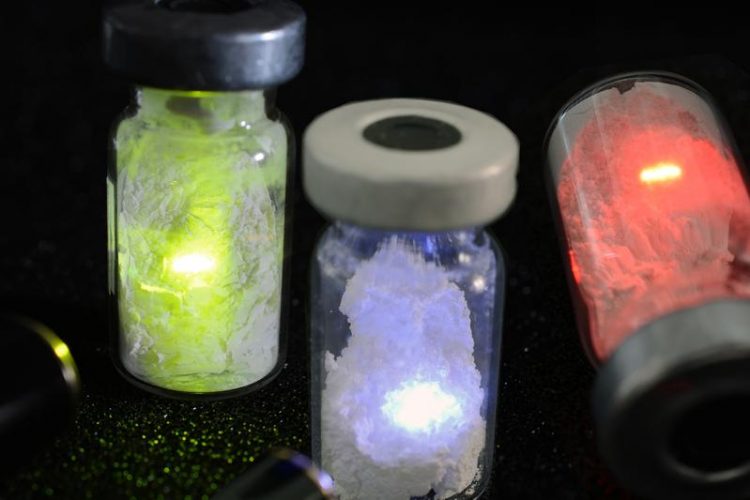Start of BMBF grant research project on Tracer-Based Sorting for packaging recycling

Fluorescence markers in different colours
In Germany, 3 million tons of packaging waste is produced annually. Packaging is discarded daily in each household and is then collected in yellow refuse bags or waste bins. How can high value secondary raw materials be recovered from this waste? Is it possible to produce new packaging materials from used packaging?
These questions are addressed in a new research project managed by professors of the Pforzheim University. In project “Marker based sorting and recycling system for plastic packaging”, or “MaReK” in short, professors Dr.-Ing. Claus Lang-Koetz and Dr.-Ing. Jörg Woidasky are collaborating with several industrial partners and one research partner in order to develop a new sorting system for plastics waste. The project was formally started earlier this month with a Kick-Off meeting at Pforzheim University.
In addition to the professors, companies Polysecure GmbH (Freiburg), Werner & Mertz GmbH (Mainz), Der Grüne Punkt – Duales System Deutschland GmbH (Köln), the Institute of Microstructure Technology of the Karlsruhe Institute of Technology (KIT), subcontractors CMO-SYS GmbH and Nägele Mechanik GmbH and Umwelttechnik BW GmbH (State Agency for Environmental Technologies and Resource Efficiency of the State of Baden-Württemberg) as associated partner are cooperating for this project. It is funded with a grant of approx. 2 million Euros by the German Federal Ministry of Education and Research (BMBF) in the framework programme „Research for Sustainable Development“ (FONA3) in funding scheme „Plastics in the Environment“.
At the core of the new sorting system is the so-called „Tracer-Based Sorting (TBS)“. By means of this technology, developed and patented by project partner Polysecure, plastic packaging sorting clearly exceeds conventional sorting approaches. Packaging can thus be sorted according to significantly more differentiated criteria than the conventional plastic type sorting that is currently available.
To this end research partner KIT is further developing the fluorescence marker substances being employed in the project. Yet, the overall objective is the pilot application under technical conditions: In a first step, marker substances will be added to packaging materials or labels of the packaging of the brands FROSCH and EMSAL from project partner Werner & Mertz.
The high-tech marker substance shows fluorescent properties when irradiated with a specific kind of light during the sorting process. The sorting machine to be developed and built by Polysecure in Freiburg is exploiting this effect for packaging identification and sorting of the marked objects. In this way plastic waste can be separated and can be specifically recycled – independently of form, colour and contamination.
“By using our fluorescence markers, plastic packaging can be separated quickly and securely, even if they have identical chemical compositions” says Jochen Moesslein, CEO of Polysecure. The development of the sorting machine is a collaboration between Polysecure and CMO-SYS GmbH and Nägele Mechanik GmbH. Bryce Richards of KIT is conducting the research on new materials at the Institute of Microstructure Technology ”We are developing marker materials so that in future a wealthof different materials can be marked” states the professor from Karlsruhe who is head of the department of Nanophotonics for Energy.
TBS technology not only allows for conventional differentiation of different plastic materials but is probing additional properties such as minor but crucial compositional differences and application.. This is very relevant for the material flow management of recycling systems as the “Grüner Punkt” that are analysing the integration and implementation of marker applications in the existing system.
“The MaReK approach allows for food packaging to be recycled to the initial application again. Also, this is the first time different types of the same polymer can be distinguished. The main objective is to meet the increased recycling quota as of 2020” explains Dr. Michael Heyde of Der Grüne Punkt – Duales System Deutschland. Consequently, TBS technology can reduce the use of primary raw material and thus lower environmental impact.
Within the scope of the research project the entire recycling process will be analysed and further developed. “On the one hand we are assessing marker materials and application areas of the retrieved secondary raw materials, and on the other hand we are working together to optimize the waste management. Moreover, we are observing the innovation effects of the technology in the market environment” says Claus Lang-Koetz. This interdisciplinary collaboration will provide the basis for an increase in material recycling of plastic packaging in the sense of the safeguarding of raw materials and reducing environmental hazards in Germany.
Media Contact
More Information:
http://www.hs-pforzheim.deAll latest news from the category: Materials Sciences
Materials management deals with the research, development, manufacturing and processing of raw and industrial materials. Key aspects here are biological and medical issues, which play an increasingly important role in this field.
innovations-report offers in-depth articles related to the development and application of materials and the structure and properties of new materials.
Newest articles

Single-Celled Heroes: Foraminifera’s Power to Combat Ocean Phosphate Pollution
So-called foraminifera are found in all the world’s oceans. Now an international study led by the University of Hamburg has shown that the microorganisms, most of which bear shells, absorb…

Humans vs Machines—Who’s Better at Recognizing Speech?
Are humans or machines better at recognizing speech? A new study shows that in noisy conditions, current automatic speech recognition (ASR) systems achieve remarkable accuracy and sometimes even surpass human…

Not Lost in Translation: AI Increases Sign Language Recognition Accuracy
Additional data can help differentiate subtle gestures, hand positions, facial expressions The Complexity of Sign Languages Sign languages have been developed by nations around the world to fit the local…



